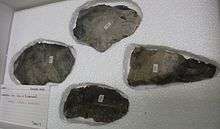Baker's Hole

Baker's Hole is an archaeological site in a former quarry at Northfleet, Gravesham, Kent, England, which has been described as "the best known British Early Middle Paleolithic (MIS 9-7) site". It produced "mostly large Levallois cores and flakes",[1] representing the discarded remains of production on a considerable scale of stone hand axe tools by a population probably consisting of Neanderthals.[2] It is described by the Kent county council archaeological service as a "Mousterian factory", with a sequence through the Clactonian, Acheulian and Mousterian archaeological industries.[3] Many of the finds are now in the British Museum, which in the past distributed small sets of artefacts to several other museums.
Location
Baker's Hole is in the Ebbsfleet valley south of the river Thames in Kent, an area rich in significant Paleolithic sites, including Swanscombe Heritage Park just to the west, and Swanscombe Thameside Community School ("Swan Valley School" in some sources) across Southfleet Road. Baker's Hole is traditionally described as in Northfleet, but is now described as in the parish of "Swanscombe and Greenhithe" by Kent County Council.[4] For the main periods of archaeological finds, the site was quarried by the Associated Portland Cement Manufacturers Ltd – the Swanscombe/Northfleet area was where William Aspdin had pioneered Portland cement in the 1840s. Quarrying is now finished and most of the site has been back-filled. Locating the precise findspots for the material described as coming from Baker's Hole is somewhat complicated, and the area from which they came is more precisely described as "Southfleet Pit" within the larger quarry; "Baker's Hole" proper is to the north, and has produced no finds.[5]
Archaeological investigations
The first finds from the Ebbsfleet valley were made in 1881 in a tramway cutting, and a local amateur archaeologist, James Cross, began collecting finds from Southfleet Pit from soon after quarrying began in 1909. Finds were published by R.A. Smith, an archaeologist from the British Museum, in 1911, although it appears that he never excavated at the site himself, but inspected, borrowed, and later published finds produced for him by the company, which they had paid the quarry workers to hand in as they came across them in their work. These were finally transferred to the British Museum in 1914 and then numbered some 750 pieces. The British Museum subsequently distributed small collections of "duplicate" material to any local museum that asked for one, and now holds 299 pieces from the "Smith Collection".[6]
The implications of this history are that, according to Rebecca Scott of the British Museum, it cannot safely be assumed that the many hand axes found on the site are from the same levels as the cores and flakes, as has often been claimed in the past.[7]
Notes
References
- Ashton, Nick, "Hunting for the first humans in Britain", British Archaeology, Iss 70, May 2003
- British History Online, "Archaeology: The Lower Palaeolithic Age", in A History of the County of Middlesex: Volume 1: Physique, Archaeology, Domesday, Ecclesiastical Organization, The Jews, Religious Houses, Education of Working Classes to 1870, Private Education from Sixteenth Century (1969), pp. 11–21. online, Date accessed: 21 October 2011.
- "Kent", Exploring Kent's Past, entry for Baker's Hole
- Scott, Beccy, "The investigation of Baker's Hole, Northfleet, Kent, 1909–1914; the impact of collection history upon the interpretation of archaeological data", online text, Proceedings of the Geologist's Association, Volume 121, Issue 1, 2010
Further reading
- "Early Palaeolithic Cultural Facies and the Levalloisian at Baker's Hole" by Francis Wenban-Smith
- Wenham-Smith website